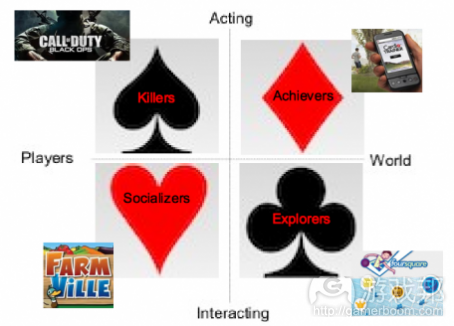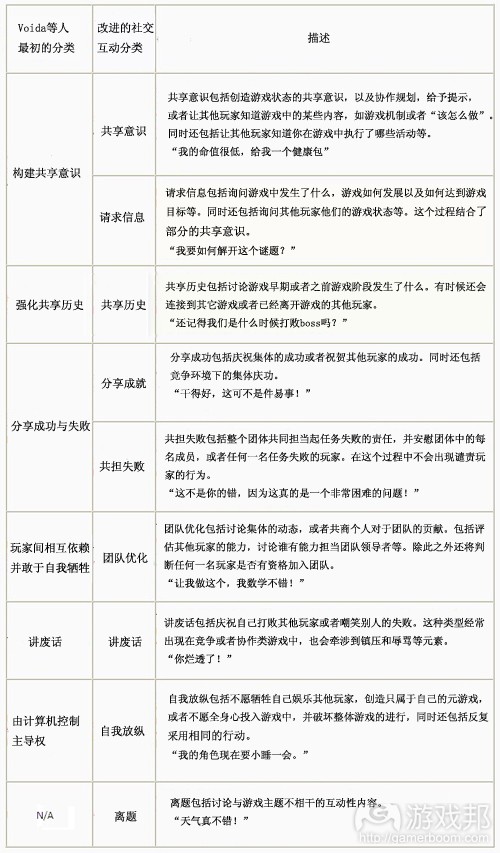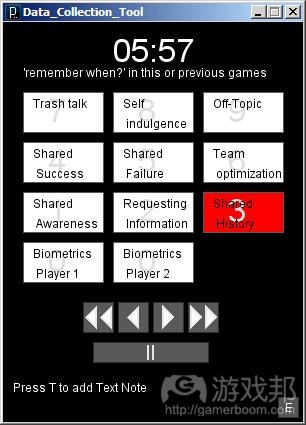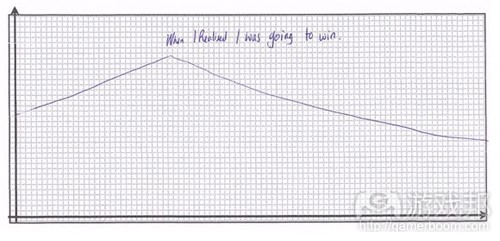以四种玩家类型衡量游戏的社交互动性
作者:Steve Bromley, Graham McAllister, Pejman Mirza-Babaei, Jonathan Napier
为何社交互动如此重要?
在多人游戏中,社交互动成为了一种越来越重要的主题。Wii的成功以及它所强调的休闲多人游戏,如《Wii Sports》或者《Just Dance》,都证明了让玩家与好友一起玩游戏,能够让游戏获得更广泛的用户基础并创造出更深刻的体验。
对于开发者来说,他们必须掌握现有的社交互动类型,并在游戏开发过程中衡量自己所侧重的类型。从Relentless Software和Vertical Slice的合作中,我们得出了一套方法论,能够帮助开发者从最早的游戏原型设计中便开始评估游戏的互动性。
这种方法不仅能够让开发者明显地衡量游戏中的互动形式,同时也能够帮助他们更好地明确目标游戏玩家,针对特定的玩家类型去开发游戏。
理解社交互动
为了衡量社交互动,游戏开发者必须先定义多人搭配游戏中的不同互动类型。
Voida, Carpendale和Greenberg在他们的学术论文《The Individual and the Group in Console Gaming》中分析了玩家在《吉他英雄》,《马里奥派对》以及《马里奥赛车》等多人社交游戏中的行为。通过观察并记录玩家在这些游戏中的不同行为,他们将互动性分为六大类型,如下表所示。Ackermann同样也展开了一项研究,即通过观察并分析LAN party(游戏邦注:由一群人暂时性、通常也是自发性的带著他们的电脑,在一个地方将电脑以局域网路连结的聚会)中玩家的互动形式,并记录下一些相似的互动分类。
将这些人的研究与Relentless Software早前关于可用性测试所得的数据结合起来,得到了以下关于互动性的分类:
Bart Stewart最近讨论了关于不同玩家类型的模式的使用,并注意到基于Bartle的四种玩家分类所得出的最受欢迎的模式。我们就使用Bartle的玩家类型理念去分辨每个玩家的个人动机。
在Bartle的理论中,每个玩家都会因为不同的游戏动机而分属于不同类别,如游戏中有80%的杀手,10%的社交家以及10%的成就者。
我们在这项研究中使用了Bartle Test,即在明确不同Bartle玩家类型之前先问玩家30个问题。并通过分析结果而确定玩家的类型。
衡量社交互动性
为了明确不同玩家类型的社交互动,并呈现我们是如何使用这一方法衡量社交互动,我们进行了8次实验测试,每次安排2名相对的游戏玩家,规定他们共有30分钟的游戏时间,并通过三角测量法和生物计量法以及所获得的玩家访问信息更好地理解他们在游戏期间的社交互动形式和效率。
这些玩家是来自于一些现有的社会团体,以此能够更容易推动他们进行互动。让两名玩家一起玩《Buzz! Quiz World》(游戏邦注:这是一款由Relentless Software开发的社交益智游戏)。
在游戏过程中,开发者使用了基于Processing的特定工具以记录不同形式的社交互动,并自动为这些数据进行分类,从而帮助开发者做进一步分析。
通过获得GSR(皮肤电反应)数据,而衡量玩家身体对于游戏事件以及不同社交互动形式所做出的反应。
GSR与一些较为鲜明的情绪(如激动或沮丧)具有直接联系,并且会表现出非特定性的情绪反应。GSR数据是先呈现于时间轴面上,再与社交互动数据联系起来。
游戏后,玩家需要在一张空白的方格纸上写下自己的游戏体验,并进行评注。这个过程是采访玩家未给予提示的行动,以此确保玩家能够即时准确地回忆起游戏过程中的感受以及各种互动事件,并对此进行客观的评估。
然后玩家将观看关于他们游戏过程的视频(以此让他们更好地回想起自己在游戏期间的想法)并接受采访。当GSR信号达到最高点或者出现明显的社交互动行为时,玩家将描述他们在那一时刻内心的真实想法。这一过程能够帮助开发者更好地明白玩家为何要这么做而不只是回答玩家是如何做的。
我们发现了什么?
就像之前所说的,我们通过四种不同的玩家类型区分不同的互动形式,以此更好地理解不同互动形式背后玩家的游戏动机。
杀手
正如我们所提到的,杀手最喜欢击败其他玩家,明显地展现出“讲废话”行为,侮辱并刺激对手。
同时我们还必须注意到,杀手在GSR测试下的情绪反应和社交互动级别会在他们即将获得胜利时出现明显的下滑——因为他们只对那些“实力相当”的对手感兴趣,这点将在后来的访问中得以证实。
建议:
他们希望游戏能够采用嘲弄机制,以此更明显地突出自己的胜利,就像战士那样。
对于这类型的玩家,开发者可以通过提供给玩家更多获得胜利的机制而确保游戏的用户粘性。早前游戏,如《马里奥赛车》或者《Buzz! Quiz World》决赛中的“rubber banding”机制便都体现了这一点,即在最后游戏关卡中将玩家之前所获得的分数变成其最后一回合的抢先优势。
成就者
成就者总是希望能够明显地展露自己在游戏中获得的成功,当游戏能够清晰地展示出他们的进程时,其社交互动和情绪反应便会达到最高级别。
《Buzz! Quiz World》的“Pie Fight”回合特别强调了这一点,即玩家如果回答错误便会遭到馅饼的袭击;以及在“Over the Edge”回合中,当玩家落向烂泥槽时,其情绪反应级别便会明显地向上窜升。
而在互动方面,成就者是宁愿放弃自己所具备的优势也希望有机会说出自己知道问题的答案。
在像《Buzz! Quiz World》这类型的小游戏中,如果对手不知道问题的正确答案,对于玩家来说便具有优势;但是对于成就者来说,他们希望能够大声说出答案,以此显示自己的知识渊博,即使必须以游戏失败为代价。显然,对于这类型玩家来说,声望比起任何游戏目标都重要。
建议:
成就者希望能够获得游戏更深层次的奖励,就像他们希望其他玩家能够在游戏中高颂自己的名字那样。
如此,针对于成就者的游戏设计必须让他们能够尽可能在每回合游戏中多展现自己的成就,不只是停留在徽章或奖杯上,还应该通过游戏机制,如统计值或游戏的支持等表现出来。
(在“Over The Edge”回合中,当玩家落向烂泥槽时,成就者的GSR信号(绿色)便会达到最高值。)
社交家
很明显,社交家们之间会展开频繁的合作活动。社交家们愿意与对手共事,讨论不同回合间的选择,以此确保彼此都能够享受到游戏的乐趣;与此相比,其他类型的玩家更愿意选择那些对手们表现欠佳的类别。
社交家具有较高级别的“共享意识”,愿意进行口头互动并共同讨论问题的答案。与成就者不同,社交家的互动具有协作性,主要关于两名玩家一起思考并想出问题的正确答案。同时,社交家对于游戏进程并不感兴趣,并且比起其他玩家类型,他们关于游戏内部事件的GSR情绪反应程度较不明显。
建议:
当社交家在与其他玩家进行交谈时将会呈现出较高级别的情绪反应,所以那些针对于社交家的游戏设计必须强调玩家间的交流,即使是在竞争类游戏中。设计者可以通过创造游戏情节或者在游戏中添加幽默元素体验出来。
探索者
探索者总喜欢不断摸索并理解游戏的广度和深度以及游戏机制,同时他们还具有较高级别的合作互动性,就像社交家那样,愿意与其他玩家在游戏中相互协作前进。
当遇到新挑战,如选择新一回合的主题,发现回合中的机制或者遇到新问题时,都会呈现出较高级别的互动性。除此之外,探索者也对游戏中的视觉要素非常感兴趣,如关于某个时间段其角色在游戏中做了些什么的描写等。与社交家一样,他们不会被《Buzz!》中明显的成功目标所吸引,探索者甚至会说“我并不在乎自己的成败。”
建议:
针对于探索者创造游戏时,设计者必须尽可能多呈现出游戏内容,不论是通过游戏机制还是图解展示。收集类小游戏如《WarioWare》和《马里奥派对》便是很好的例子,它们都鼓励探索者们在游戏中进行社交互动。
切记
开发者必须清楚,因为众口难调,针对于任何一种玩家类型设计游戏都会导致其无法适用于他类型的玩家,以此设计团队必须慎重考虑这个问题,自己评估采用这个方法的结果是否有悖于他们最初的开发目标。
总结
与Relentless Software合作共同进行游戏开发,采取区分不同社交互动形式的方法能够帮助开发者明确地是哪些元素引起玩家的不同反应。在开发过程中使用这一方法论能够帮助设计者针对特定的互动形式或者不同的玩家类型而定制游戏。
这一研究主要呈现了社交小游戏《Buzz! Quiz World》中不同玩家类型,包括喜欢嘲弄别人的高度竞争型杀手玩家,夸夸其谈的成就者,以及重视团体协作的社交家等所体现出的不同社交互动形式。而不同游戏类型,从第一人称射击游戏到角色扮演游戏对于这一方法的使用也将体现出不同玩家类型的不同交互特征。同时这一方法也能够帮助开发者更好地探索更大群体玩家间的社交互动变化。
(本文为游戏邦/gamerboom.com编译,拒绝任何不保留版权的转载,如需转载请联系:游戏邦)
Playing to Win? Measuring Social Interaction in Games
by Steve Bromley, Graham McAllister, Pejman Mirza-Babaei, Jonathan Napier
Why is Social Interaction Important?
Social interaction is becoming an increasingly important theme in multiplayer gaming. The success of the Wii, and its focus on casual multiplayer games such as Wii Sports or Just Dance, has highlighted how important playing with friends is to reaching wider audiences and creating successful game experiences.
For developers, it’s therefore important to be able to understand the types of social interaction that exist, and measure them during the development of games. In a collaboration between Relentless Software and Vertical Slice, we have been developing a methodology to allow developers to evaluate interaction from the very earliest prototypes.
This not only allows developers to measure the forms of interaction evident in their game but also, through increasing our ability to profile players, allows developers to target games towards specific gamer types.
Understanding Social Interaction
In order to measure social interaction, it is first important to define the types of interaction that occur during multiplayer collocated (i.e. sat in the same room) gaming.
Voida, Carpendale, and Greenberg, in their paper The Individual and the Group in Console Gaming, observed people playing multiplayer social games such as Guitar Hero, Mario Party and Mario Kart. By noting and defining the forms of behavior evident in these sessions, they categorized interaction into six groups, presented below. Ackermann also conducted a study, coding and analyzing the forms of interaction noted by players at LAN parties, and noted similar interaction categories.
By combining their research with data from previous Relentless Software usability tests, the following categories of interaction were defined:
Voida et al.’s Original Category
Revised Social Interaction Category
Description
Constructing Shared Awareness
Shared Awareness
Shared Awareness includes building a shared awareness of the game state, and can include collaborative working out, giving hints, or making another player aware of something within the game, such as game mechanics or “what to do”. It can also include reporting to other players what activities you are performing within the game.
“Let me have the health pack, I’m low on health”
Requesting Information
Requesting Information typically includes asking about what is happening in game, how the game works, or how to achieve their goal. It can also include asking other players to report their status. It is often combined with a period of shared awareness.
“How do I solve this puzzle?”
Reinforcing Shared History
Shared History
Shared History includes discussing what happened earlier in the game, or in a prior play session. May include links to other games, or with players not present.
“Remember when we beat that boss?”
Sharing in Success and Failure
Shared Success
Shared Success includes celebrating a group success, or congratulating another player on their success. It can include a group celebration despite being in a competitive situation.
“Well done, that was really hard!”
Shared Failure
Shared Failure includes taking group responsibility for failing a task, offering reassurance, or commiserating with a player who has failed a task. It does not include blame (which may be more appropriate under Trash Talk).
“It’s not your fault, it was a difficult question!”
Engaging in Interdependence and Self-Sacrifice
Team Optimization
Team Optimization includes discussing the group dynamics, or negotiating an individual’s contribution to the group. It can include assessing the ability of others, and discussions over who is leading or in control. Can also include denying players the chance to join in.
“Let me do this bit, I’m better at math!”
Talking Trash
Trash Talk
Trash Talk includes celebrating your own success over the other players, or laughing at their failure. This can be in competitive or collaborative game types, and often involves put downs or insults.
“You suck!”
Falling Prey to the computer’s holding power
Self Indulgence
Self Indulgence includes not playing the game at the expense of other players’ enjoyment, making up one’s own meta-game, or not participating fully, leading to a disruption of the flow of the game. It can include repeatedly performing the same action (i.e. viewing a hidden in-game feature or Easter egg).
“My character’s going to have a nap now.”
N/A
Off Topic
Off Topic includes discussing non-game based interaction or discussion
“Nice weather we’re having!”
Bart Stewart recently discussed the use of models for player types, and noted that the most popular model from Bartle divides players into four types, as follows. We have also used the same idea of player types as a way to distinguish between each player’s individual motivations.
Player Type
Description
Killers (Clubs)
Killers are interested in combat/competition with other human players, and prefer this over interaction with non-player characters.
Achiever (Diamonds)
Achievers are most interested in gaining points or alternative in-game measurements of success. These players will often go out of their way to gain items that have no in-game benefit besides prestige, such as Achievements’ or Trophies.
Explorer (Spades)
These players are interested in discovering the breadth of a game, and will explore new areas or take non-optimal routes to explore. They do not like time limits, since this limits the potential to explore options.
Socializers (Hearts)
These players are interested in the social aspect of game play, rather than the game itself. They enjoy interacting with other players, and use the game primarily as a means of communication.
In Bartle’s theory, each individual player’s motivation stretches across each group, with a player being scored in each category, i.e. 80 percent killer, 10 percent socializer, 10 percent achiever.
For this study, the online Bartle Test was utilized, which asks the user 30 questions, before giving them a Bartle player type. For analysis of the results, we divided players by their type.
Measuring Social Interaction
To understand how social interaction differs across player types, and to show the application of the methodology for measuring social interaction, we ran eight lab sessions, each with two collocated players, 30 minutes of playtime, and triangulated social interaction, biometric, and player interview data to gain a better understanding of the forms, and effects, of social interaction during gameplay.
The players were picked from pre-existing social groups to encourage interaction. Pairs of players were asked to play a game of Buzz! Quiz World, the social quiz game created by Relentless Software.
During these sessions, a custom tool, created in Processing, was used to record the forms of social interaction noted, and automatically timestamp the data for further analysis.
Throughout the session GSR (galvanic skin response) data was taken, measuring how their body reacted to the in-game events and the forms of social interaction noted.
GSR has a linear correlation with arousal (such as excitement or frustration) and reflects non-specific emotional response. The GSR data was presented on a timeline, and was later correlated with the social interaction data.
After the session, players were asked to record their experience on blank graph paper, and annotate this. This was done unprompted, before interviewing the players, to ensure that a fair representation of their memories of the session, and the events/interaction that occurred during it, could be evaluated.
The custom social interaction recording tool
The players were then interviewed while watching a video of their play session in order to gain an understanding of what they were thinking throughout the session. When prompted by peaks in the GSR signal or a-typical social interaction behavior, the players were asked to describe what they were thinking or doing at that moment. This gave increased insight into why players were acting as they were, not just how they acted.
A player’s self-assessed “experience” graph
What Did We Find?
As mentioned, we broke the results down by the four player types, to gain greater insight into the motivations behind each form of interaction noted.
Killers
Killers, who as we noted are most interested in defeating other players, showed the highest degree of the “trash talk” behavior, insulting and goading their opponent.
It was also interesting to note that Killers’ levels of arousal, as identified by GSR, and social interaction, dropped significantly when it was obvious they were going to win — they are only interested in “worthy” opponents, as was confirmed later by the interviews.
A Killer’s self assessed “experience” graph
Recommendations:
Their desire for defeating other players could be realized and emphasized in game through the introduction of taunt mechanics in games, as are found in many fighters.
Game mechanics can be introduced to ensure continued engagement by ensuring that all players always have the opportunity to win. This has previously been seen through the rubber banding in games such as Mario Kart, or the final round of Buzz! Quiz World, which converts the score players have earned throughout the game into a head start in the last round.
Achievers
Achievers, who are defined by their interest in visibly demonstrating their success at a game, showed the highest level of interaction and arousal when the game displayed a visible indication of their progress.
In Buzz! Quiz World, this was noted particularly for the Pie Fight round, where the players received a pie in the face for an incorrect answer, and in the Over the Edge round, which raised players who were doing badly towards a sludge tank.
In their interactions, it was also noted that achievers were prepared to give up their advantage to verbally demonstrate that they knew the answer.
In trivia games like Buzz! there is an advantage if your opponent doesn’t know the right answer; however, achievers were noted to say their answers out loud while answering, demonstrating their superior knowledge, at the cost of in-game success. Evidently prestige is more important than the game’s defined objectives.
Recommendations:
Achievers described how they’d like further rewards in game, as demonstrated by comments that they’d like the audience to chant their name in-game.
As such, a game can be tailored towards encouraging interaction from achievers by offering the opportunity to visibly display success in each round against their opponent, not just through badges and trophies, but through in-game mechanics, such as stats and support!
A player falling towards the sludge in Over The Edge, with a visible peak in the Achiever’s GSR signal (green)
Socializers
Among socializers, it was noted that their interaction was primarily collaborative. Socializers would work together with their opponent, and discuss the choice of rounds to ensure that they both shared enjoyment in the game session, whereas other player types often chose categories their opponent would perform poorly in.
Socializers demonstrated the high degree of “shared awareness” verbal interactions, and discussed the answers. Unlike achievers, this interaction was collaborative and involved two players working out the correct answer to the questions together. It was also noted that socializers were uninterested in the progress of the game, and showed a low level of GSR arousal to in-game events, compared to other player types.
Recommendations:
Due to the high level of arousal noted when socializers talked to one another, the recommendation can be made to emphasize communication between the players, even in typically competitive gameplay, to ensure that they remain engaged in the game. This can be achieved through development of plot or the use of humor.
Explorers
Explorers, who are defined by their interest in exploring and understanding the breadth and depth of the game and its mechanics, also demonstrated a high level of cooperative interaction — and, like socializers, worked together with other players while describing what was happening in the game.
They showed the highest level of interaction when engaged by new challenges, such as selecting the topic for a new round, discovering the mechanics of the round, or being asked new questions. Explorers also demonstrated a high level of interest in the visual aspects of the game, such as describing what their in-game avatars were doing at the time. Like socializers, they were not engaged by Buzz!’s overt success goals, and a explorer even said “I’m not interested if I win or lose.”
Recommendations:
When targeting games towards explorers, it is important to display a wide variety in content, both in the game mechanics and graphically. Minigame collections, such as WarioWare and Mario Party are good examples of games that encourage social interaction from explorers.
An Important Note
It is important to recognize in the recommendations for all player types that optimizing a game towards one player type may create a detrimental experience for other types, and hence it will be important for the design team to evaluate the results of this method against their development goals.
Where Next?
Developed in partnership with Relentless Software, the methodology for live-coding the forms of social interaction that occur during gameplay allows great insight into precisely what elements of a game cause reactions with players. The application of this methodology during development can allow designers to tailor a game towards emphasizing specific forms of interaction, or targeting specific player types.
This study has shown how the forms of social interaction differ for each player type in the social trivia game Buzz! Quiz World, from the taunting of highly competitive killers, the boasting of achievers, or the collaborative discussion of socializers. The application of this to different game types, from FPSs to RPGs, would reveal interesting distinct traits in the interactions found among each player type in response to more directly competitive play. There is also potential to explore how social interaction changes among larger groups of players.(source:gamasutra)














































 闽公网安备35020302001549号
闽公网安备35020302001549号